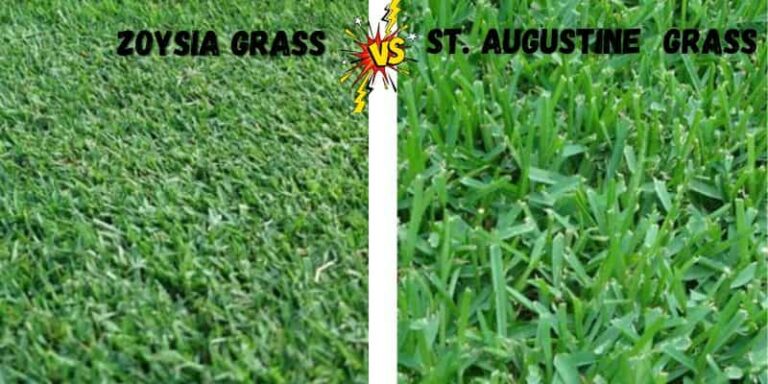Zoysia Grass – Identification, Care, Planting, Cost & More
Zoysia is a warm-season grass identified by its fine, stiff, dense growth habit. It spreads via above-ground stolons and underground rhizomes. Zoysia is established vegetatively through sod, sprigs, or plugs since seeding is often unreliable. Sodding offers the fastest fill-in but is more expensive, costing $0.30-0.70 per square foot. Sprigs and plugs planted 6-12 inches apart are slower to establish but cheaper.
Proper watering and weed control are critical when planting. Once established, zoysia has good pest and disease resistance but can still be damaged by grubs, armyworms, and diseases like brown patches, dollar spots, and rust. Preventive fungicide programs and proper cultural practices are key. Zoysia tolerates heat, drought, and traffic, making it ideal for lawns, golf courses, and sports fields. However, thatch management through dethatching and aeration is needed to prevent buildup.
In this blog, we look at Zoysia grass and its identification characteristics, varieties, care, and maintenance needs like mowing, irrigation, and fertilization to provide a lush, dense turf carpet.
Table of Contents
What is Zoysia Grass?
Zoysia grass is a warm-season dark-green turfgrass with a fine-medium texture. This grass is native to Asia and was introduced into the USA in 1895. Since then, American homeowners have increasingly preferred it for their lawns due to its dense growth habit, great heat tolerance, and decent cold tolerance. At least 11 zoysia grass species are used as turfgrass across the country.
Here is its taxonomical classification
- Kingdom: Plantae
- Division: Magnoliophyta
- Class: Liliopsid
- Subclass: Commelinidae
- Order: Cyperales
- Family: Poaceae
- Genus: Zoysia
How to Identify Zoysia Grass (with pictures)
You can identify zoysia grass through the features of the leaves, seedhead/flowers, stems, and its growth habit.
Leaves
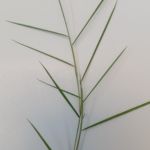
The zoysia leaf blade is stiff, short, slender (0.08-0.16 inches) and has a pointed tip. The leaf blade is hairy on the upper side. It has rolled vernation and lacks auricles, and the ligule is a fringe of hairs, each about 0.008 inches long. Meanwhile, the collar is continuous and has hairy edges. The leaf sheath is split and has tufts of hair at the throat.
Stems
Zoysia grass stems are hardy and stiff since they have a high silica content.
Flowers
The inflorescence is a spike with 3-12 or 10-50 spikelets, depending on the Zoysia species. The flowers are small, greenish, and inconspicuous but lack petals and sepals. Flowering occurs in the northern hemisphere during the summer months, typically June to August. Seeds form within weeks of flowering if fertilization occurs but most Zoysia cultivars have limited seed production and are best propagated vegetatively.
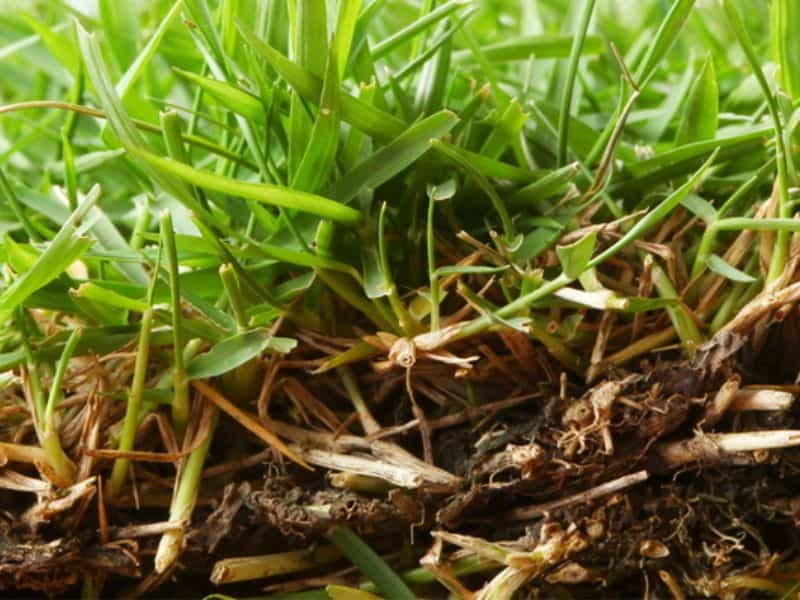
Growth Habit
Zoysia spreads via underground runners (rhizomes) and above-ground lateral runners (stolons). This grass grows close to the ground and forms dense turf once fully established.
Note: Zoysia japonica varieties are coarse-textured, while Zoysia matrella varieties are fine-textured.
Here is a profile table for Zoysia grass:
| Zoysia Grass Characteristic | Description |
|---|---|
| Botanical Name | Zoysia spp. (Z. japonica, Z. matrella, Z. pacifica) |
| Growth Habit | Perennial warm-season grass |
| Establishment | Vegetative – sod, plugs, sprigs. Slow from seed. Spread via rhizomes and stolons. |
| Texture | Medium to fine, dark green in color |
| Flower | Small, green, wind-pollinated spikelets that produce inconspicuous inflorescences during summer, with limited seed production. |
| Tolerance | High drought tolerant, moderate shade tolerance, moderate cold tolerance, and excellent heat tolerance. Excellent foot traffic tolerance. |
| Major pests and diseases | Pests: Grubs, billbugs. Diseases: Dollar spot, brown patch, rust |
| Uses | Lawns, sports fields, golf courses |
| Origin | Native to Asia, Australia |
| Cultivars | Meyer, Emerald, Zeon, Zorro, etc |
How to Establish Zoysia Grass Lawn
The most effective way to establish Zoysia grass turf is through vegetative propagation methods like sodding, plugging, and sprigging. However, seeding is also a viable option for some Zoysia grass varieties.
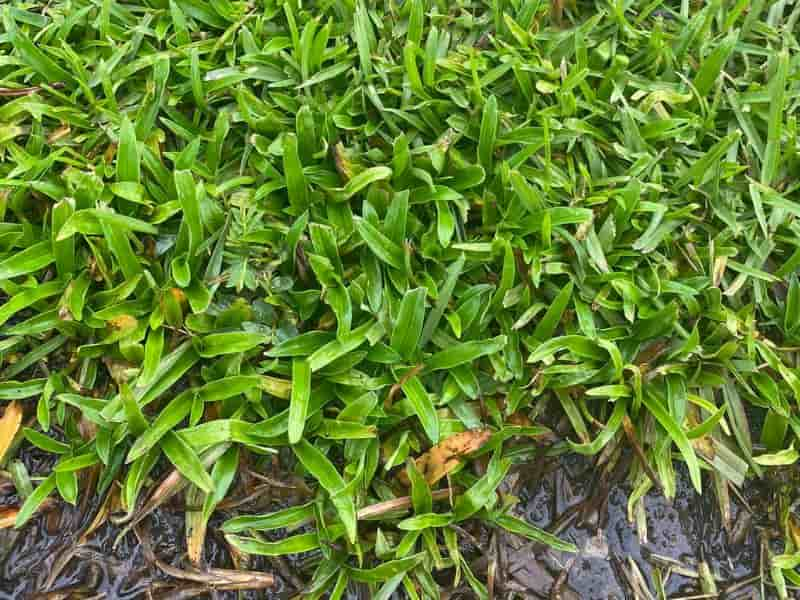
Sod
Sodding is the fastest but most expensive way to establish a Zoysia grass lawn. Before installing sod pieces, water the area to moisten the soil for optimal rooting.
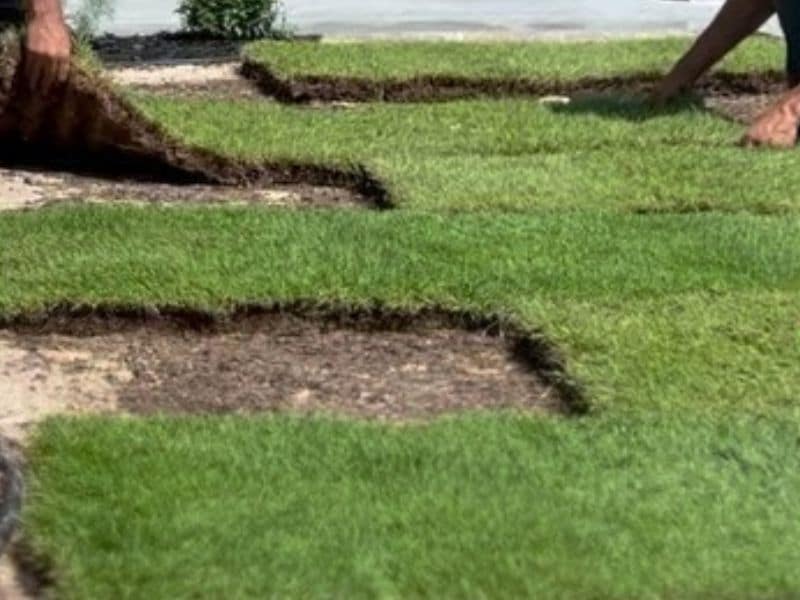
Install the sod pieces in a staggered pattern and fit them tightly against each other such that there are no visible gaps between adjacent sod pieces. After laying down the sod, lightly tamp the lawn to provide firm contact with the soil. You can also go over the lawn with a roller to level it.
Plugs and sprigs
Plugs are small cores of sod, while sprigs are sections of stolons or rhizomes. To establish zoysia grass from plugs, make small furrows using a trowel. The holes should be two inches deep and 6-12 inches apart.
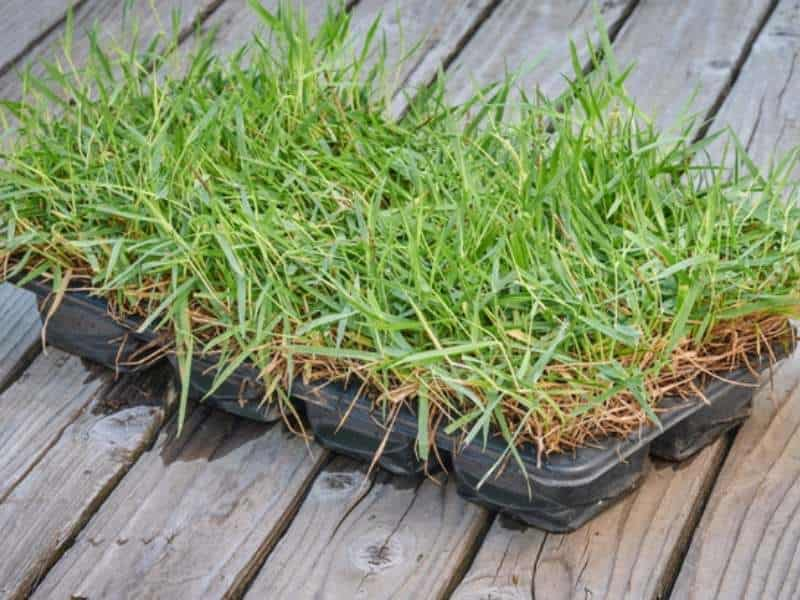
Remember, the closer you plant the plugs, the faster your zoysia lawn will fill in. Then, plant the plugs in the holes, cover them with soil, and lightly tamp the ground to ensure proper contact with the soil. Finally, water the area immediately after planting.
After that, don’t let the soil dry out. At the very least, lightly irrigate the lawn once daily for the first 14 days post-planting. Increase the watering frequency to 2-3 times daily if it’s hot and dry. Meanwhile, hand-pull weeds growing between the plugs, as they’re usually detrimental to turf development.
Zoysia sprigs are also established much in the same way as the plugs. Always ensure that each sprig is buried at least 2 inches deep and some part remains above the ground. Also, don’t let the sprigs dry out when planting. Note that sprigging is less expensive than plugging, but sprigs are less likely to withstand adverse conditions compared to plugs.
Seed
Only Zoysia japonica cultivars produce viable seeds and can be established by seeding. When establishing Zoysia from seed, don’t cover the seeds with soil, as Zoysia seeds require optimal light exposure to germinate.
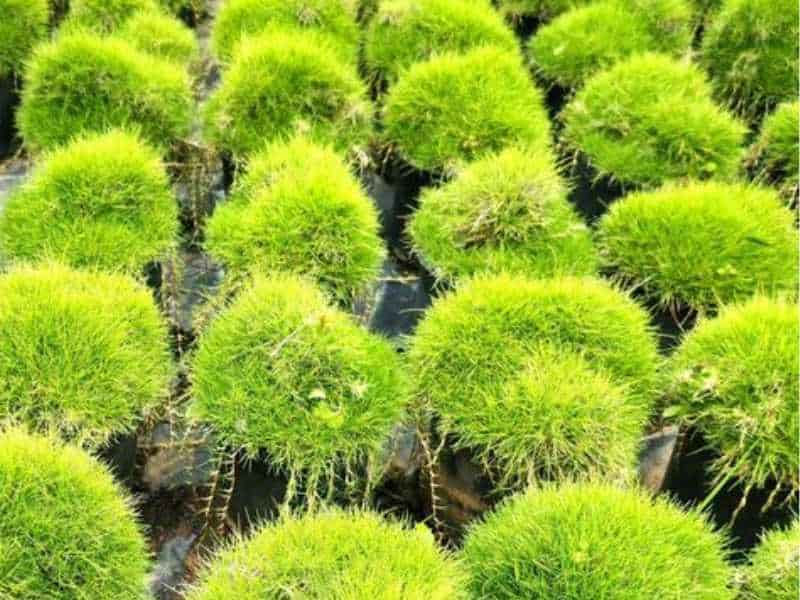
It takes 6-8 weeks for a Zoysia lawn grown from seed to establish fully, but the turf quality is often poorer; thus, vegetative propagation is preferable.
Zoysia Grass Care and Maintenance
Zoysia is a relatively low-maintenance turfgrass, as it only requires occasional watering and minimal supplemental fertilization. Zoysia tolerates low light shady areas and has great weed resistance once it becomes established. Still, you need to care for and maintain your Zoysia grass lawn if you want it to stay healthy. Proper care and maintenance practices include watering, mowing, fertilization, dethatching, aeration, and weed control.
Watering
Zoysia grass roots grow deep into the soil; thus, it conserves moisture and can withstand short periods of drought. However, it won’t withstand prolonged drought. Deeply water your Zoysia lawn to promote deeper rooting.
Ideally, you should provide it with one inch of water per week from March to May. Then, during the hot summer, provide the lawn with 1.25 inches of water weekly. You can then go back to one inch of water weekly in the fall. Finally, in the winter, water is only as necessary to prevent desiccation.
Remember, you should always consider rainfall when watering Zoysia to avoid overwatering the lawn. For instance, if it’s raining in the fall, you should only supply supplemental irrigation such that the total moisture content in the soil is to a depth of one inch. Conversely, if you have sandy soil, you may have to water more frequently (2-3 times weekly) to prevent the soil from drying out.
Fertilization
Zoysia grass only requires two pounds of nitrogen fertilizer per 1000 square feet for the growing season to stay healthy and attractive. Overfertilization may cause stunted root development, excessive top growth, excessive thatch, and increased disease vulnerability.
Before applying fertilizer, perform a soil test to determine any nutrient deficiencies. If there are no major deficiencies, apply fertilizer with a 3-1-1, 4-1-1, or 4-1-2 ratio from May-August. You don’t want to feed the soil too early, as this will promote weed growth. Similarly, late fertilization from September onwards isn’t recommended as it interrupts the natural hardening process.
Meanwhile, if the soil test results show that the soil is phosphorus/potassium deficient, the best Zoysia fertilizer with a ratio of 1-1-1 or 2-1-1 is preferable.
Mowing
Generally, Zoysia grass should be mowed at a height of 1-2.5 inches, taking care not to remove more than 30% of the grass leaf blade surface area at any one time. Note that fine-textured varieties can be mowed at lower heights up to 0.75 inches.
During spring, when the turf is recovering from dormancy, mow at the lower limit (1 inch) to remove dead grass tissue and promote faster green-up. Then, in the summer, when the turf has greened up and is between 3-4 inches tall, mow medium-coarse textured Zoysia at a height of 1.75-2.5 inches. Meanwhile, for fine-textured Zoysia, mow weekly at 0.75 inches.
After mowing your Zoysia lawn, leave the grass clippings on the lawn to feed the soil naturally and reduce the need for chemical fertilizer application. Also, Zoysia is stiff and difficult to mow, often blunting mower blades. Ensure that you re-sharpen the blades after every mowing session in readiness for the next time you mow.
Dethatching
Zoysia grass is prone to thatch buildup from dead stolons, rhizomes, and stem tissue. Excessive thatch that exceeds 0.5 inches high is detrimental for turf growth and should be reduced. Dethatch the lawn in early summer with a power rake or verticutter with the blades set one inch apart.
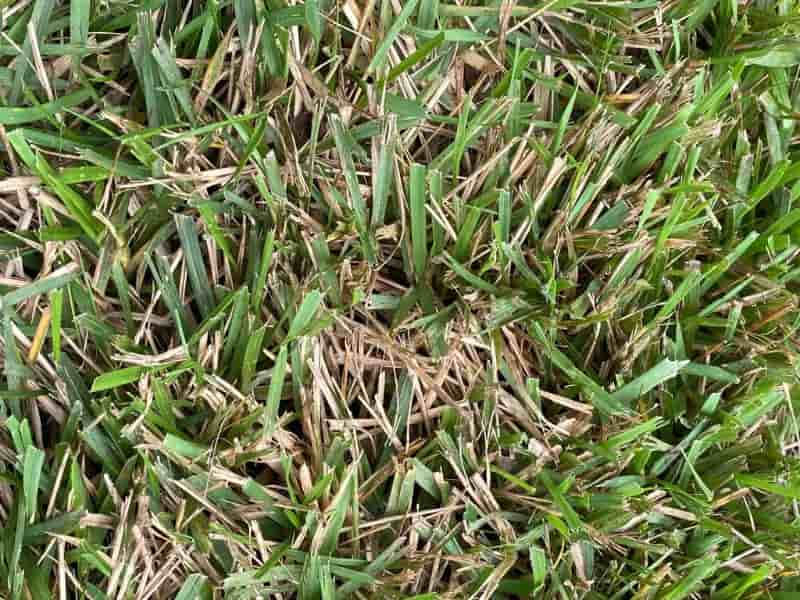
Meanwhile, if the thatch layer exceeds one inch, don’t try removing all of it in one year, as you’ll cause extensive physical injury to your Zoysia lawn. Instead, dethatch over a 2-3 year period.
Note: Dethatching should be accompanied by core aerification to improve water and nutrient penetration into the soil.
Weed control
Zoysia grass easily outcompetes most weeds if properly managed. However, it’s still vulnerable to winter weeds like henbit, wild violet, dandelion, and chickweed, which take over the lawn as the Zoysia goes dormant. Other factors, such as aggressive dethatching, insect invasion, and disease, can promote weed takeover.
You can prevent the sprouting of winter weeds by applying a pre-emergent herbicide in the fall. For existing weeds, spot spray with a post-emergent herbicide.
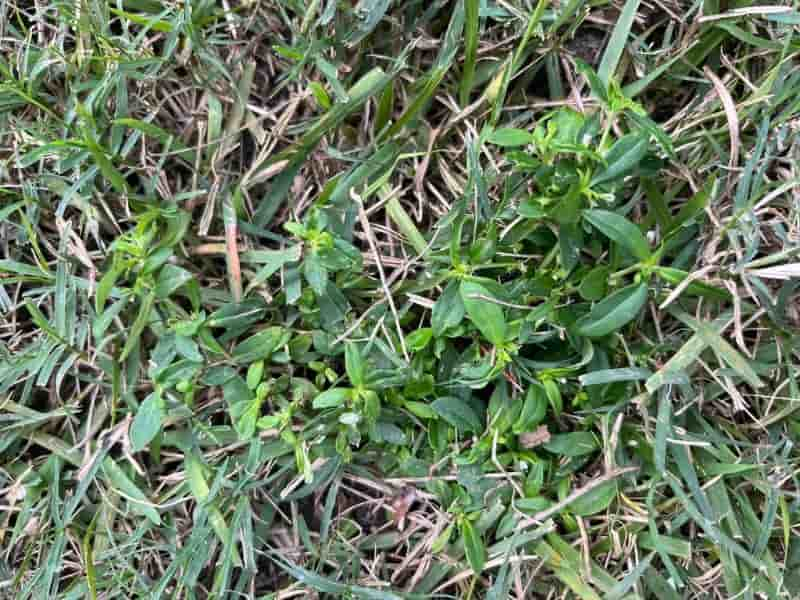
Varieties
There are several varieties of zoysia grass, but commonly used in residential, commercial, and sports landscapes fall mainly under three species: Zoysia japonica, Zoysia matrella, and Zoysia pacifica.
- Zoysia Japonica– these cultivars have the fastest growth rate amongst Zoysia grasses and are also cold-hardy. They include El Toro, JaMur, Empire Turf, Meyer, Palisades, and Zenith.
Note: Zenith is a Zoysia cultivar that retains its green color longer in winter than other Zoysia varieties.
- Zoysia Matrella– these cultivars form fine-textured, dense turf and have exceptional shade tolerance and salt tolerance. They include Cashmere, Diamond, Trinity, Taccoa Green, Thrive, Geo, Zeon, and Zorro.
- Zoysia Pacifica– These cultivars have the finest texture but poor cold tolerance. They’re best for use in southern lawns with mild winters.
Note: Hybrid Zoysia varieties are developed by combining two or more cultivars from the species discussed above. Hybrid Zoysia cultivars include Emerald (japonica x matrella), Zeon (matrella x pacific), CitraZoy, Icon, and Innovation. The hybrids and cultivars are commonly bred for improved traits like cold tolerance, texture, color, etc
Pests
Generally, Zoysia grass has good pest resistance. However, insects like white grubs, mole crickets, and billbugs can sometimes invade and cause turf damage. You can prevent excessive pest damage by detecting these insects early and applying insecticides.
- Billbugs– these insects feed on Zoysia roots, resulting in random patches of dead turf. They typically invade in the fall and spring, preferring low-nutrient and dry turf. You can get rid of billbugs using a pyrethroid insecticide. Keep the turf well-watered and fertilized to lower the chances of infestation.
- White grubs– these bugs feed on Zoysia grass roots, causing wilting and turf yellowing. White grubs are also attractive to critters like raccoons and armadillos, which can cause worse turf damage. Use an Imidacloprid-based insecticide to get rid of white grubs effectively.
- Mole crickets– these insects tunnel through the soil, causing grass roots to dislodge from the soil. Consequently, areas of the turf dry out and die. You can eliminate mole crickets on Zoysia with a bifenthrin-based pesticide.
Diseases
Zoysia grass is susceptible to various diseases, the most common of which are large patches, dollar spots, and rust. Typically, these diseases make the turf weaker and less attractive but won’t kill the grass.
- Large patch– The fungi that cause this disease become active in the fall when soil temperatures drop to between 65°F and 75°F. It causes large patches of brown turf, which can last well into the next summer since Zoysia grass is slow to green up after winter dormancy. You can treat large patches using a fungicide, but the best control is prevention by dethatching and avoiding excessive nitrogen fertilizer application.
- Dollar spot– round, bleached spots on the grass blades characterize this disease. It is caused by nitrogen deficiency and can be treated by lightly applying nitrogen fertilizer.
- Rust– when you notice tiny orange/yellow pustules on your Zoysia grass blades, you most likely have a rust problem. Rust occurs when humidity is high and can be treated using fungicides. Meanwhile, control practices such as proper mowing help reduce infection chances.
- Other common diseases include: brown patches, fusarium blight, crown rot, leaf spot disorder, powdery mildew, fairy rings, and pythium blight among others.
Other Problems with Zoysia Grass
Additional factors that can diminish the quality of Zoysia grass turf include moisture stress, excessive shade, soil compaction, high traffic, and pH imbalance. It’s, therefore, important to maintain the proper lawn care practices to keep the lawn in good shape. These practices include avoiding overwatering/underwatering, amending soil pH, and mowing at the right height.
Uses of Zoysia Grass
Zoysia grass thrives in different soil types and tolerates various mowing heights. Therefore, it can be used in several applications, including home lawns, sports fields, and golf courses.
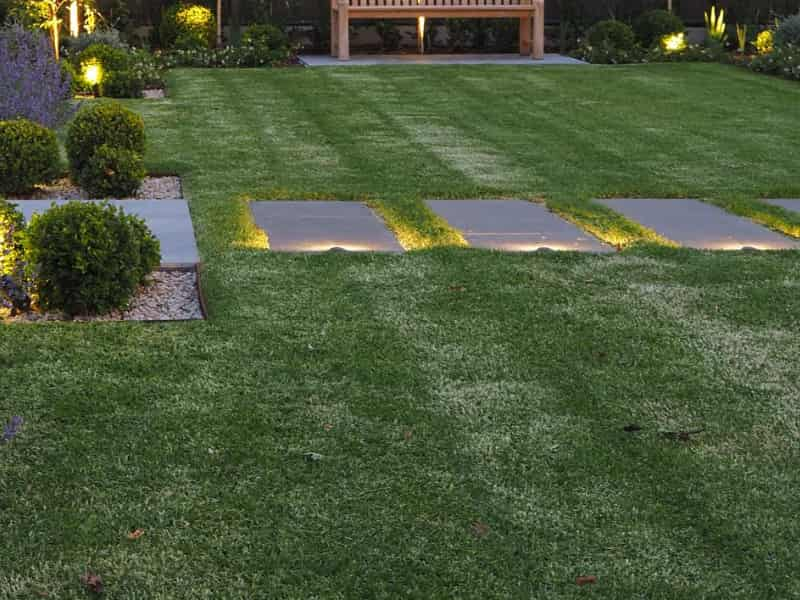
- Home lawns– Zoysia grass forms a dense mat of bright green turf that’s visually pleasing and forms a perfect playground for kids when used on home lawns.
- Golf courses– Zoysia grass grows relatively slowly, thus giving golf course maintenance staff an easier job. Also, it can be mowed low and used on the putting green and fairway or mowed high and used in the rough.
- Sports fields– hardy Zoysia varieties have excellent wear tolerance and can be used on sports fields without much harm.
Note: Zoysia is deep rooted grass and one of the grass varieties that thrive in sandy soil.
What does Zoysia fungus look like?
Zoysia fungus (large patch disease) appears as roughly circular dead patches up to several feet wide in the grass lawn. The patches are mottled tan and brown, and the grass blades of the infected part of the lawn thin out. The edges of the dead patches may look reddish-brown in color.
How do you prevent Zoysia fungus?
Proper lawn care practices like proper mowing height, irrigation, and fertilization help promote healthy turfgrass and can help prevent fungus infestation. In addition, improving drainage in soggy lawns and avoiding watering late in the day reduces a conducive environment for fungus growth.
You may opt to apply preventative fungicides like; chlorothalonil, myclobutanil, and azoxystrobin or curative fungicides like propiconazole and thiophanate-methyl. For effectiveness, its good to rotate the use of different fungicide classes on your lawn.
How can you tell the difference between Zoysia and fescue?
Distinguishing between Zoysia grass and fescue involves key characteristics.
Zoysia has fine blades, about 1/16″ wide, forming a dense mat through stolons and rhizomes. It feels coarse, has a grey-green color, and thrives in full sun. Zoysia goes dormant and turns brown after the first frost, requiring mowing under 2″. In contrast, fescue has wider blades (up to 1/4″), grows in clumps, feels softer, and is a deeper green. It prefers cooler temperatures, tolerates some shade, and stays greener in winter. Fescue is best mowed at 3-4″.
Additionally, Zoysia originates from Asia, while fescue species have European origins. Understanding these distinctions is essential for effective lawn care management based on the specific needs of each grass type.
References
- University of Missouri Extension: Establishment and Care of Zoysia Grass Lawns
- N.C. Cooperative Extension: Zoysia spp.

